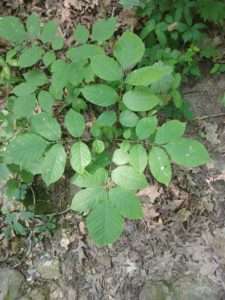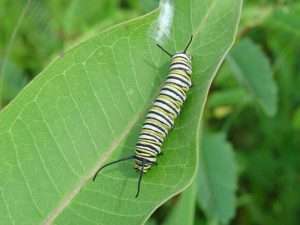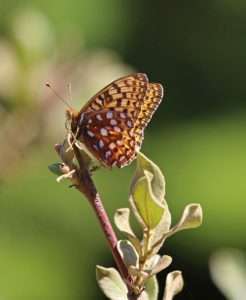
Earlier this year a study was released that explored the viability of alternative hosts for caterpillars for whom ash trees (Fraxinus spp.) are the primary food source. Ash trees are in severe danger of extinction in North America due to the introduction of the emerald ash borer (Agrilus planipennis), a tiny green beetle that is wreaking havoc as an invasive species both here and in Europe.
The researchers chose three representative Lepidoptera species–Ceratomia undulosa, Sphinx kalmiae, and Sphinx chersis–and offered them lilac (Syringa vulgaris), weeping forsythia (Forsythia suspensa), and European privet (Ligustrum vulgare) as potential alternatives in the laboratory. They also placed several caterpillars on trees outdoors to see if setting had any effect.
The result? Not only were some of the alternatives toxic to some of the caterpillars, but they often ended up with significant signs of malnutrition. Some simply starved to death, and those that managed to reach pupation did so later than they would have on ash trees. Moreover, the majority of moths that emerged from cocoons had deformed wings and would never have been able to fly.

This study confirms what native plant advocates have been saying for decades: native insects need native plants. Caterpillars are just a fraction of the herbivorous insects out there, and most of these herbivores are only evolved to eat a few plants–in some cases they are dependent on one species alone. So why do insects need native plants so much?
Living beings have certain chemicals in them called metabolites. These molecules are produced as part of the process of an organism’s metabolism, and while primary metabolites are necessary for the way an organism develops and basic life processes, secondary metabolites have other important purposes.
Plants often have metabolites that are designed to keep animals from eating them. Caffeine and capsaicin are two good examples. While we super-omnivorous humans are capable of ingesting these chemicals–and often come back for more–most herbivorous insects can’t tolerate them. Instead, they usually have tolerances for a very narrow range of metabolites amid the vast array of chemicals produced by the plant kingdom.
It can take many generations for a species of animal to develop a tolerance to a single metabolite. This is why we see herbivores–especially insects–primarily eating plants that their species have evolved alongside for many thousands of years in the same ecosystems.
What this means is that when a specialist herbivore’s host species goes locally extinct, the insects can’t just go and eat another nearby plant, even if it’s also native to the area. A good example is the Oregon silverspot butterfly (Speyeria zerene hippolyta), which historically flew in meadows along the west coast of the United States from northern California to the Long Beach Peninsula of Washington. The only food that the caterpillar of this species can eat is the leaves of the early blue violet (Viola adunca).

As meadows were plowed up, developed, or closed in by forests due to fire suppression, the early blue violets began to disappear. So, too, did the butterflies diminish in number, until they were only found in five very small locations within their historic range–four in Oregon, and one in California. Efforts to reintroduce them have been ongoing for the past couple of decades, but reintroduction of the butterflies must always be preceded by reintroduction and protection of the violets their caterpillars need.
The good news is that when we plant native plants, we’re creating food and habitat for native wildlife. Insects and other invertebrates may directly eat the plants, as will herbivorous vertebrates. And then other animals eat the herbivores–many songbirds, for example, must have a diet made primarily of insects in the first few weeks of their lives or they will die of malnutrition before they ever leave the nest. And so that energy continues to radiate throughout the food web. But it all has to start with those native plants that photosynthesize and then provide food to those animals that are capable of eating them.
If you want to add some native plants to your garden–even a balcony container garden counts–you’ll need to do a little research to find the species that are the best match for where you are. In North America we have it pretty easy; there are plenty of field guides and other books on native plants, and even native plant nurseries that specialize in regional species. If you’re in the United States, you can use the Native Plant Finder to search for native plants by zip code. Almost all states have a Native Plant Society that you can send questions to as well.
Depending on where you live resources may be more sparse, but you might try asking at nurseries and garden centers, state, territorial, or federal parks and refuges, and even university botany and other natural history departments for suggestions on where to start looking. If there aren’t any native plant nurseries near you and no way to get them via mail order, you may find yourself trying to find places nearby where you can legally dig up native plants to transplant; just be aware that this can also transport diseases and pests as well. It’s better to try to source some seeds or seedlings to start with that were grown in cleaner greenhouses and nurseries.
And again, you don’t have to do a complete habitat restoration in your yard. Even a few natives mixed into your garden can make a big difference to your local ecosystem!

Excellent!
Thank you!
On a different note, is there any way to subscribe to your blog? I like your posts, especially since they’re reflecting some of the same issues I see in my corner of the PNW, but I’m bad about making the rounds to individual websites.